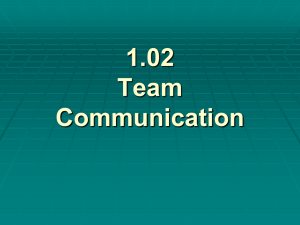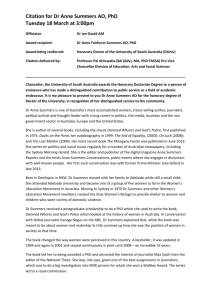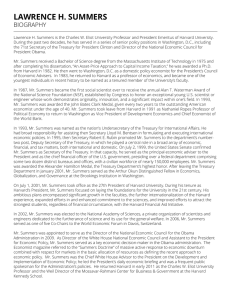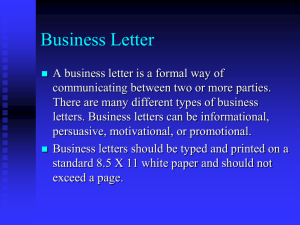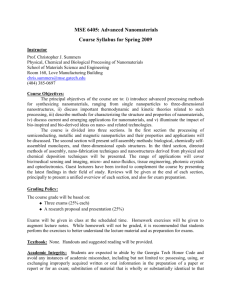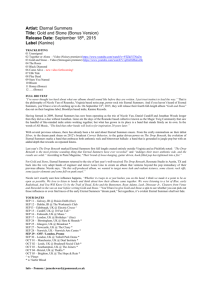Lab Manager Job Manual
advertisement
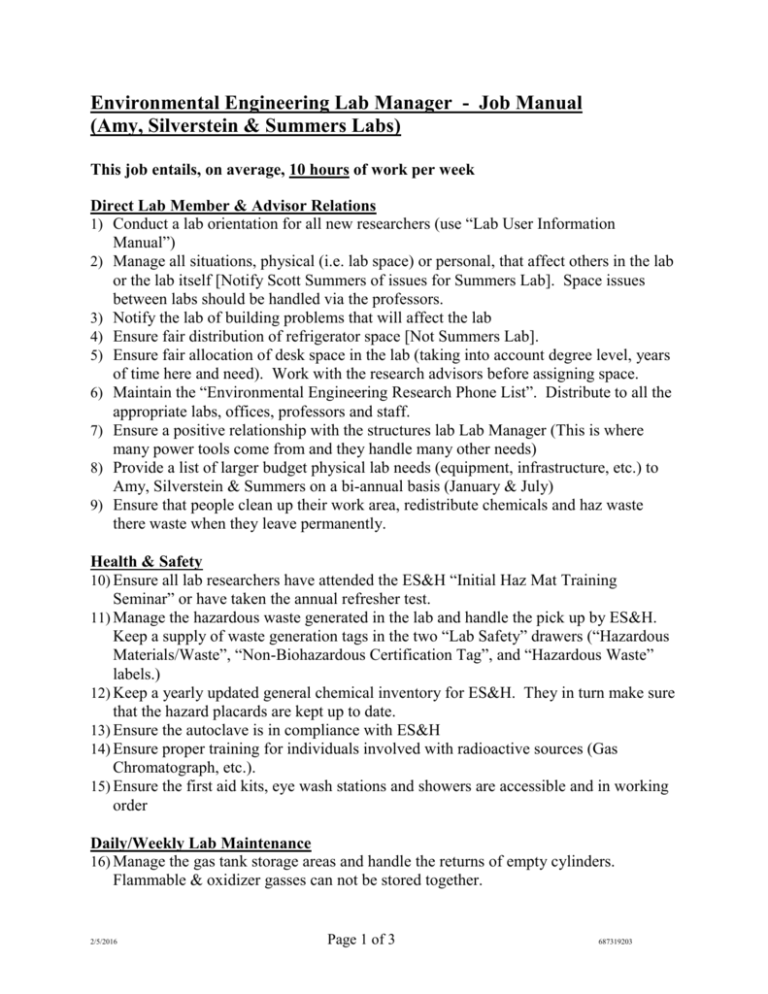
Environmental Engineering Lab Manager - Job Manual (Amy, Silverstein & Summers Labs) This job entails, on average, 10 hours of work per week Direct Lab Member & Advisor Relations 1) Conduct a lab orientation for all new researchers (use “Lab User Information Manual”) 2) Manage all situations, physical (i.e. lab space) or personal, that affect others in the lab or the lab itself [Notify Scott Summers of issues for Summers Lab]. Space issues between labs should be handled via the professors. 3) Notify the lab of building problems that will affect the lab 4) Ensure fair distribution of refrigerator space [Not Summers Lab]. 5) Ensure fair allocation of desk space in the lab (taking into account degree level, years of time here and need). Work with the research advisors before assigning space. 6) Maintain the “Environmental Engineering Research Phone List”. Distribute to all the appropriate labs, offices, professors and staff. 7) Ensure a positive relationship with the structures lab Lab Manager (This is where many power tools come from and they handle many other needs) 8) Provide a list of larger budget physical lab needs (equipment, infrastructure, etc.) to Amy, Silverstein & Summers on a bi-annual basis (January & July) 9) Ensure that people clean up their work area, redistribute chemicals and haz waste there waste when they leave permanently. Health & Safety 10) Ensure all lab researchers have attended the ES&H “Initial Haz Mat Training Seminar” or have taken the annual refresher test. 11) Manage the hazardous waste generated in the lab and handle the pick up by ES&H. Keep a supply of waste generation tags in the two “Lab Safety” drawers (“Hazardous Materials/Waste”, “Non-Biohazardous Certification Tag”, and “Hazardous Waste” labels.) 12) Keep a yearly updated general chemical inventory for ES&H. They in turn make sure that the hazard placards are kept up to date. 13) Ensure the autoclave is in compliance with ES&H 14) Ensure proper training for individuals involved with radioactive sources (Gas Chromatograph, etc.). 15) Ensure the first aid kits, eye wash stations and showers are accessible and in working order Daily/Weekly Lab Maintenance 16) Manage the gas tank storage areas and handle the returns of empty cylinders. Flammable & oxidizer gasses can not be stored together. 2/5/2016 Page 1 of 3 687319203 - each individual is responsible for filling out the return sheet for their cylinders. Lab Manager calls in pick-ups 17) Maintain the DI systems 18) Maintain the MQ systems 19) Empty the broken glass containers when full (goes to the dumpster) 20) Ensure the janitors are taking out the trash & sweeping the floors (every Tuesday & Thursday). Patricia (2-3930) is the contact for the janitors. Trash cans are handled by Ed at facilities management (2-5321, edward.vonbleichert@colorado.edu). 21) There are two catalog shelves. The main catalog shelf is in the Amy lab. There is a smaller selection of the more used catalogs in the Summers lab. Keep the catalog inventory up to date and in alphabetical order. Write room # on the catalogs so they stay put. 22) Ensure all doors are locked at 5:00 if you are around Monthly Lab Maintenance 23) Maintain general lab supplies consisting of, but are not limited to the following: - Paper towels - tools - Hand soap - lab tape (limited) - Powdered soap for glassware - pH paper (limited) - Kim wipes - balance supplies - Latex gloves (non-powdered) - safety glasses - Parafilm - baking soda & sodium hydroxide Lab supplies are kept in the designated cabinet in the instrument lab & Summers lab. 24) Ensure that all equipment has a responsible person for its maintenance or maintain it yourself [Only track changes for Summers Lab] 25) Ensure that experiment and equipment procedures are recorded, updated and are available for all major experiments via the “Environmental Engineering Labs website”. Keep an electronic copy of all of these in your files. 26) Ensure that equipment user manuals are properly filed/stored and available. These are located in the Amy, Silverstein, and Summers lab file cabinets. 27) Ensure the HVAC system and lights are working. Call the Building Proctor, Araceli Warren 2-7427, for these needs. 28) When needed and able, install or repair equipment, hardware, lines etc. in the lab 29) Maintain the drying oven 30) Maintain the dry chemical storage shelves 31) Maintain the acid, base and flammable liquid, non-toxic/non-flammable liquid, and toxic/non-flammable liquid/solid storage areas 32) Maintain the storage room downstairs 33) Maintain the lab manager binder & file cabinet drawer (located in Amy lab) 34) Turn in the “gas cylinder accounting sheets” to Zoe. 35) Maintain tool drawers, miscellaneous stuff cabinet, and parts drawers. 36) Ensure recycling bins are emptied when full by calling CU recycling for pickup 2-5321. 2/5/2016 Page 2 of 3 687319203 Monthly Office Maintenance 37) Ensure the office area is kept clean and in compliance with department office standards. 38) Ensure the lights are working. Call the Building Proctor, Araceli Warren 2-7427, for replacement. Yearly Lab Maintenance 39) Have floors cleaned & waxed by janitors, coordinate with Patricia (2-3930). This is free once per year and is usually performed over winter break. 40) Replace the MQ cartridges and tape the “date replaced” on the cartridge housing. Order from Millipore, “Milli-Q UF Pyrogen-Free Ultrapure Cartridge Kit”, part # “CFUF01204” ($275). Property Management 41) When new equipment shows up in the lab that is worth more than $5000 or the equipment is a computer originally purchased under the faculty computer program, contact the Department Property Manager for a property tracking tag (which he/she should already have). An inventory is performed by the Department Property Manager every 2 years. 42) Computers & other electronics – This equipment must be disposed through Property Services. Consultation should be made with the Department Property Manager. The general process is a “Equipment and Furniture Disposal Request” form must be submitted to Property Services and they come pick up the equipment. Any tagged equipment must be properly transferred via appropriate paperwork. Items to do upon change of Lab Manager 1) Change contact info as “alternate safety contact” on the radioactive source license with ES&H. 2) Change name on all emergency contact labels on lab and office doors. 3) Let department safety officer know of lab manager change. 4) Familiarize the new lab manager with all aspects of the job. 5) Give an electronic copy of the “Environmental Engineering Research Phone List”, all experiment and equipment procedures, lab manager job description, lab user information manual to Amy, Silverstein & Summers and the next lab manager to help ensure these records get passed on and saved. Each professor will have a dedicated CD for this information. This provides a backup for the files located on the website. 2/5/2016 Page 3 of 3 687319203

